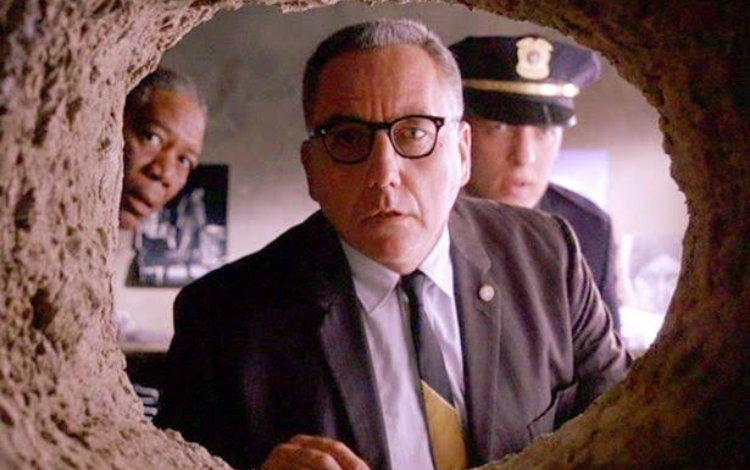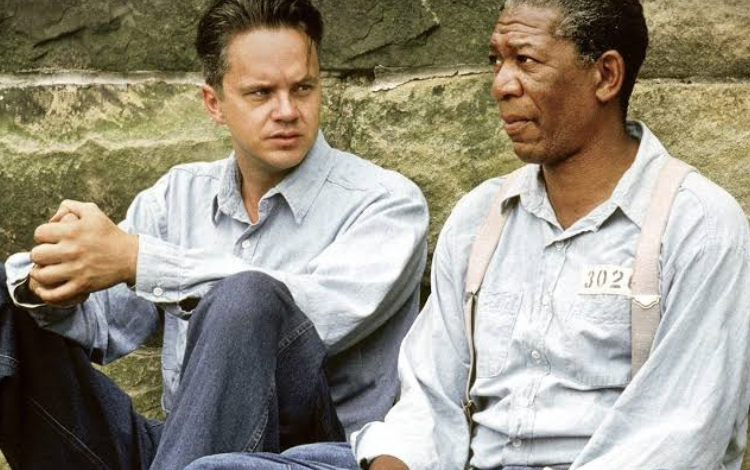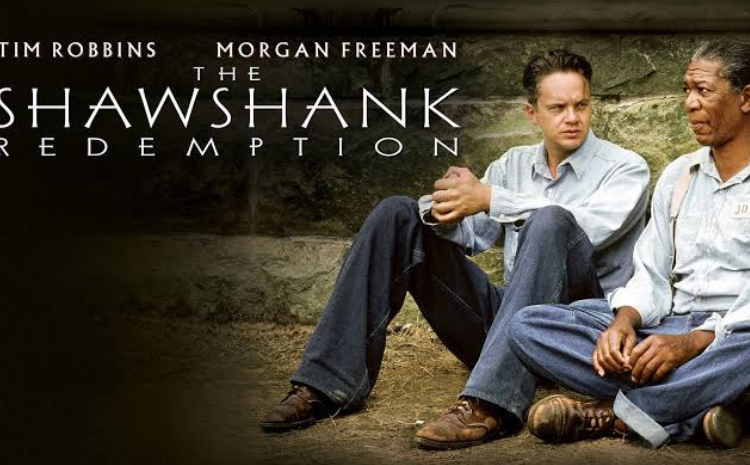“The Shawshank Redemption,” directed by Frank Darabont and released in 1994, is a cinematic masterpiece that has stood the test of time. Based on Stephen King’s novella “Rita Hayworth and Shawshank Redemption,” this film is often regarded as one of the greatest movies ever made. Its enduring appeal lies in its powerful storytelling, exceptional performances, and profound themes of hope, friendship, and redemption.

Plot Summary:
The film revolves around Andy Dufresne (played by Tim Robbins), a successful banker who is wrongfully convicted of the murder of his wife and her lover. He is sentenced to life imprisonment at Shawshank State Penitentiary. Inside Shawshank, Andy befriends Ellis “Red” Redding (played by Morgan Freeman), a long-term inmate known for his ability to procure contraband items. Despite the harsh realities of prison life, Andy maintains his innocence and never loses hope.
As the story unfolds, Andy uses his intelligence and financial acumen to assist the prison staff, earning their trust and privileges in return. He helps the corrupt warden Samuel Norton (played by Bob Gunton) with money laundering and turns Shawshank into a profitable operation. Through his acts of kindness and determination, Andy also impacts the lives of fellow inmates, offering them a glimmer of hope amid the darkness of incarceration.
Themes:
At its core, “The Shawshank Redemption” explores several profound themes that resonate deeply with viewers:
Hope and Redemption: The film beautifully portrays the transformative power of hope and the possibility of redemption even in the bleakest of circumstances. Andy’s unwavering hope and resilience inspire not only the inmates of Shawshank but also the audience, reminding us of the human capacity to overcome adversity.

Friendship and Companionship: The friendship between Andy and Red is the emotional anchor of the film. Their bond transcends the prison walls and becomes a symbol of solidarity, support, and understanding. Their friendship highlights the importance of companionship in the face of isolation and despair.
Institutionalization: “The Shawshank Redemption” critiques the dehumanizing nature of institutions, particularly the prison system. It raises questions about the impact of long-term incarceration on human beings, exploring the psychological effects of institutionalization on both inmates and prison staff.
Corruption and Morality: The film delves into the themes of corruption and morality, depicting the consequences of unchecked power and unethical behavior. Warden Norton’s exploitation of the inmates for personal gain serves as a stark commentary on the abuse of authority.
Character Development:
The strength of “The Shawshank Redemption” lies in its well-developed characters, each with their unique struggles and aspirations. Andy Dufresne undergoes a remarkable transformation from a broken man to a symbol of hope. His intelligence, integrity, and determination make him a captivating protagonist. Red, on the other hand, provides the film’s narration, offering insights into the minds of the inmates and serving as a voice of reason and wisdom.
The supporting characters, including Brooks Hatlen (played by James Whitmore), an elderly inmate who struggles to adjust to life outside prison, and Tommy Williams (played by Gil Bellows), a young convict with a tragic fate, add depth to the narrative. Each character’s journey contributes to the overarching themes of the film, emphasizing the complexities of the human experience.
Direction and Cinematography:
Frank Darabont’s direction is nothing short of masterful. He skillfully captures the gritty atmosphere of Shawshank while infusing moments of beauty and poignancy. The film’s cinematography, led by Roger Deakins, is visually striking, employing a mix of shadows and light to create a cinematic canvas that reflects the characters’ emotional states. From the vast, imposing prison walls to the liberating rain-soaked finale, every frame is meticulously composed, enhancing the film’s impact on the audience.
Performances:
The performances in “The Shawshank Redemption” are outstanding, elevating the characters from words on a page to fully fleshed-out individuals. Tim Robbins delivers a nuanced portrayal of Andy, balancing vulnerability with quiet strength. Morgan Freeman’s narration and his portrayal of Red add depth and emotional resonance to the film. Freeman’s voice becomes the soul of the narrative, guiding the audience through the story’s highs and lows.
The supporting cast, including Bob Gunton as the morally bankrupt Warden Norton and William Sadler as the relentless Heywood, deliver memorable performances that contribute to the film’s authenticity. Each actor immerses themselves in their roles, bringing authenticity and complexity to the characters they portray.
Musical Score:
Thomas Newman’s musical score for “The Shawshank Redemption” is both haunting and uplifting. The score weaves seamlessly into the narrative, enhancing the film’s emotional impact. The iconic “Shawshank Redemption” theme, with its ethereal piano melody, has become synonymous with the film itself. Newman’s compositions evoke a wide range of emotions, from despair to hope, perfectly complementing the story’s emotional beats.
Legacy and Impact:
Since its release, “The Shawshank Redemption” has achieved cult status and continues to resonate with audiences worldwide. Its enduring popularity can be attributed to its universal themes, compelling characters, and powerful storytelling. The film has received critical acclaim, earning multiple award nominations and finding a permanent place in the hearts of movie enthusiasts.
Beyond its critical acclaim, “The Shawshank Redemption” has left an indelible mark on popular culture. Lines from the film, such as Andy’s quote, “Hope is a good thing, maybe the best of things, and no good thing ever dies,” have become iconic, inspiring countless individuals facing adversity.
The film’s influence extends to various media, including television shows, music, and even politics. It has been referenced in numerous films and TV series, cementing its status as a cultural touchstone. Additionally, the Shawshank Trail in Mansfield, Ohio, where the film was shot, has become a tourist attraction, drawing fans from around the globe.
Conclusion:
“The Shawshank Redemption” is a cinematic gem that continues to captivate audiences with its timeless storytelling, stellar performances, and profound themes. Its ability to evoke a wide range of emotions, from despair to hope, makes it a transcendent cinematic experience. Through its characters’ journeys, the film reminds us of the enduring power of hope, friendship, and the human spirit.
As the credits roll and the haunting strains of Thomas Newman’s score linger, “The Shawshank Redemption” leaves viewers with a sense of awe and inspiration. It serves as a testament to the transformative power of cinema, leaving an indelible mark on the hearts and minds of those who have had the privilege to witness its brilliance. In the grand tapestry of filmmaking, “The Shawshank Redemption” stands tall as a beacon of storytelling excellence, reminding us of the enduring magic of the silver screen.
Writer
Md Ashikur Rahman
Intern, Content Writing Department
Requin BD
.





11 Comments
binance
February 12, 2025
Your point of view caught my eye and was very interesting. Thanks. I have a question for you.
binance
February 15, 2025
I don’t think the title of your article matches the content lol. Just kidding, mainly because I had some doubts after reading the article.
create binance account
February 23, 2025
Your point of view caught my eye and was very interesting. Thanks. I have a question for you.
binance Registrācijas bonusa kods
March 2, 2025
Your article helped me a lot, is there any more related content? Thanks!
Vytvorení bezplatného úctu
March 2, 2025
I don’t think the title of your article matches the content lol. Just kidding, mainly because I had some doubts after reading the article.
binance
March 4, 2025
Thank you for your sharing. I am worried that I lack creative ideas. It is your article that makes me full of hope. Thank you. But, I have a question, can you help me?
binance
March 5, 2025
Thanks for sharing. I read many of your blog posts, cool, your blog is very good.
skapa binance-konto
March 11, 2025
Your point of view caught my eye and was very interesting. Thanks. I have a question for you.
binance Sign Up
March 11, 2025
I don’t think the title of your article matches the content lol. Just kidding, mainly because I had some doubts after reading the article.
注册
March 22, 2025
Your article helped me a lot, is there any more related content? Thanks!
binance signup bonus
March 27, 2025
I don’t think the title of your article matches the content lol. Just kidding, mainly because I had some doubts after reading the article.